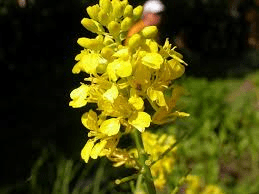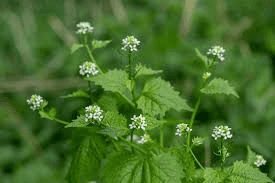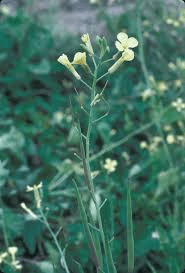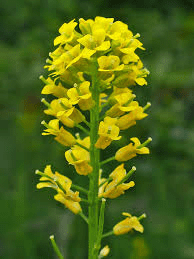Mustard inflorescence refers to the arrangement of flowers in mustard plants (genus Brassica), and it plays a crucial role in their reproductive process. Inflorescence is the term used to describe the way flowers are organized on the plant, and in mustard plants, it typically takes the form of a raceme.
In mustard plants, the inflorescence is usually a raceme, which is an unbranched, elongated cluster of flowers arranged on a central stem. Each flower is attached to the stem by a short stalk called a pedicel. This arrangement allows multiple flowers to be displayed in a linear sequence along the main axis. The raceme structure helps optimize pollination by providing a more organized and accessible arrangement of flowers for pollinators.
The mustard inflorescence develops at the top of the flowering stem, which emerges from the base of the plant. The flowers within the inflorescence are generally small and have a distinctive cross-shaped (cruciform) appearance, which is characteristic of the Brassicaceae family. Each flower typically has four petals arranged in a cross pattern, along with four stamens that surround the pistil.
The flowering process in mustard plants begins with the opening of these flowers, which usually happens sequentially from the bottom of the raceme to the top. This sequential blooming ensures that the plant remains attractive to pollinators for a longer period, increasing the chances of successful cross-pollination. Pollinators, such as bees and butterflies, visit the flowers to collect nectar and pollen, facilitating the transfer of pollen from one flower to another.
After pollination, the flowers produce seed pods, which are also known as siliques. These pods develop along the inflorescence, maturing into elongated capsules that contain numerous seeds. The arrangement of the inflorescence helps ensure that the seed pods are well-positioned for dispersal. When mature, the pods dry out and split open to release the seeds, which can then be dispersed by wind, water, or animals.
The structure and development of the mustard inflorescence are essential for the plant’s reproductive success. By ensuring that flowers are well-arranged and accessible for pollinators, the inflorescence enhances the chances of effective pollination and subsequent seed production. Additionally, the arrangement of seed pods along the inflorescence helps maximize seed dispersal.
Studying the inflorescence of mustard plants can provide valuable insights into their reproductive strategies and help improve agricultural practices. For example, understanding how different environmental factors influence inflorescence development can lead to better crop management and increased yields.
Moreover, research into inflorescence patterns can inform breeding programs aimed at developing mustard varieties with desirable traits, such as improved flower production or resistance to environmental stress.
The mustard inflorescence is a raceme arrangement of flowers that plays a key role in the plant’s reproductive process. It helps facilitate pollination, seed production, and dispersal, making it a critical component of the mustard plant’s life cycle. Understanding the inflorescence structure and function offers valuable insights into plant biology and agriculture.
The Economic Importance and Uses of Mustard Inflorescence

1. Culinary Use: Mustard inflorescence, or the flowering part of the mustard plant, is sometimes used in gourmet dishes and salads for its unique flavor and visual appeal.
2. Medicinal Use: In traditional medicine, mustard inflorescence is believed to have properties that can aid in treating respiratory issues and inflammation.
3. Nutritional Supplements: Mustard inflorescence contains beneficial compounds that are occasionally included in dietary supplements for their potential health benefits.
4. Animal Feed: Inflorescences can be used in animal feed, providing additional nutrients and enhancing livestock diets.
5. Fertilizer: Mustard plant residues, including inflorescences, can be composted to produce nutrient-rich organic fertilizer.
6. Natural Pesticide: Mustard inflorescence can be used in natural pesticides, helping to control pests in agriculture.
7. Biofuel Production: Research is exploring the use of mustard inflorescences in biofuel production as part of a sustainable energy strategy.
8. Skincare Products: Extracts from mustard inflorescence are used in some skincare products for their potential anti-inflammatory and antioxidant properties.
9. Traditional Medicine: Mustard inflorescence is used in traditional remedies to address various health issues, including skin conditions and respiratory ailments.
10. Antimicrobial Agents: Mustard inflorescence can be used in natural antimicrobial products to preserve foods and improve hygiene.
11. Agricultural Use: Mustard inflorescence contributes to soil health and fertility when used as green manure or compost.
12. Flavoring Agent: Inflorescence can be used as a unique flavoring agent in certain culinary applications.
13. Preservative: Mustard inflorescence has preservative qualities that can be used in extending the shelf life of certain foods.
14. Cosmetic Use: Mustard inflorescence extracts are sometimes included in cosmetics for their potential to improve skin appearance and health.
15. Research and Development: Mustard inflorescence is being studied for potential applications in biotechnology and pharmaceutical research.
16. Health Products: Inflorescence is used in some health products for its potential antioxidant and anti-inflammatory effects.
17. Economic Crop: Mustard plants, including their inflorescences, contribute to the agricultural economy through diverse applications and value-added products.
18. Sustainable Practices: Utilizing mustard inflorescence supports sustainable agricultural and industrial practices by maximizing the use of plant resources.
Read Also: 20 Medicinal Health Benefits Of Corydalis yanhusuo (Chinese Skullcap)
The Products and By-products That Can Be Derived From Mustard Inflorescence

1. Mustard Inflorescence Extract: Used in supplements and skincare products for its potential health benefits.
2. Mustard Inflorescence Powder: Made by drying and grinding the inflorescence, used in culinary and medicinal applications.
3. Mustard Inflorescence Oil: Extracted oil used in cosmetics and traditional medicine.
4. Mustard Inflorescence Tea: Brewed from dried inflorescence, used for its potential health benefits.
5. Mustard Inflorescence Paste: Blended form used in medicinal and culinary applications.
6. Mustard Inflorescence Fertilizer: Composted inflorescence used to enrich soil and improve crop yields.
7. Mustard Inflorescence Compost: Organic compost made from inflorescence and other plant residues.
8. Mustard Inflorescence Biofuel: Biofuel produced from mustard inflorescence and other plant materials.
9. Mustard Inflorescence Dye: Natural dye made from mustard inflorescence, used in textiles.
10. Mustard Inflorescence Pesticide: Natural pesticide made from mustard inflorescence to control pests in agriculture.
11. Mustard Inflorescence Skincare Cream: Creams containing mustard inflorescence extracts for skin benefits.
12. Mustard Inflorescence Soap: Soap made with mustard inflorescence extracts for its potential skin benefits.
13. Mustard Inflorescence Capsules: Capsules containing powdered mustard inflorescence used as a dietary supplement.
14. Mustard Inflorescence Tincture: Alcoholic extract used in traditional medicine for various ailments.
15. Mustard Inflorescence Flakes: Dehydrated and flaked mustard inflorescence used in specialty foods.
16. Mustard Inflorescence Infusion: Infused oils and liquids for culinary and medicinal purposes.
17. Mustard Inflorescence Enzyme: Enzyme preparations derived from mustard inflorescence for biotechnological applications.
Read Also: 23 Medicinal Health Benefits Of Astragalus canadensis (Canadian Wild Licorice)
Frequently Asked Questions (FAQ’s) About Mustard Inflorescence

1. What are the health benefits of mustard inflorescence? Mustard inflorescence is believed to have antioxidant and anti-inflammatory properties that may support overall health and wellness.
2. How can I use mustard inflorescence in cooking? Mustard inflorescence can be used in gourmet dishes and salads for its unique flavor and visual appeal.
3. Are mustard inflorescence products safe for pets? Mustard inflorescence products should be used with caution around pets, as some parts of mustard plants can be harmful to animals.
4. How should I store mustard inflorescence? Mustard inflorescence should be stored in a cool, dry place to maintain its quality and effectiveness.
5. Can mustard inflorescence help with skin conditions? Mustard inflorescence extracts are used in some skincare products for their potential to reduce inflammation and improve skin health.
6. What are the different types of mustard plants? Common types of mustard plants include yellow (white), brown, and black mustard, each with distinct characteristics and uses.
7. How do I prepare mustard inflorescence for use? Mustard inflorescence can be dried, ground, or used fresh depending on the intended application.
8. Can mustard inflorescence be used as a natural pesticide? Yes, mustard inflorescence can be used to create natural pesticides to help control garden pests.
9. What is the nutritional value of mustard inflorescence? Mustard inflorescence contains some nutrients and beneficial compounds, though it is less nutrient-dense compared to other parts of the plant.
10. How is mustard inflorescence used in traditional medicine? In traditional medicine, mustard inflorescence is used to treat various health issues, including respiratory problems and inflammation.
Read Also: What Are the Benefits of Growing Jasmine Flowers?






